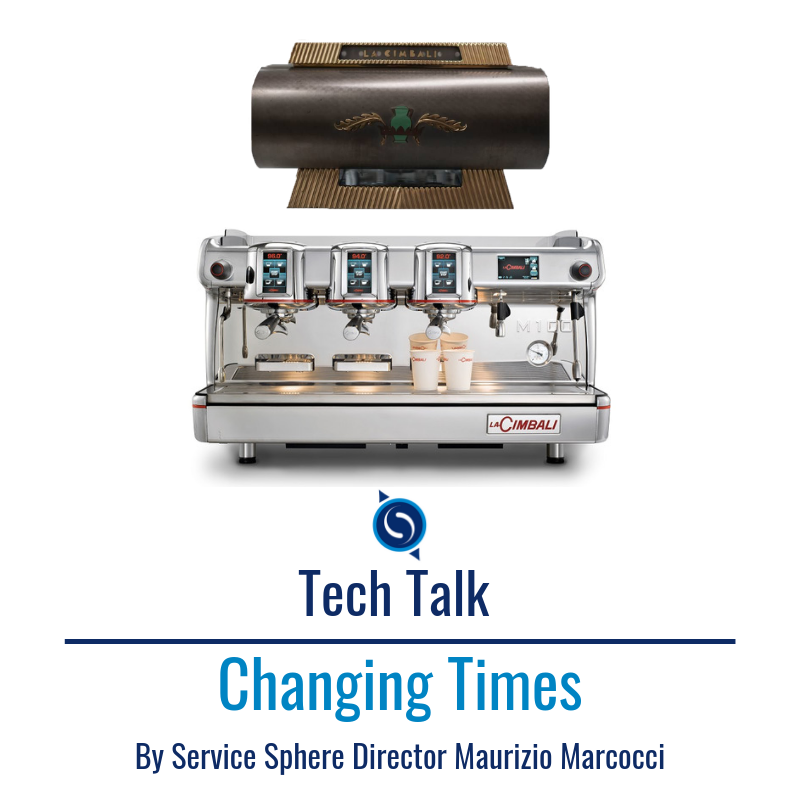Maurizio Marcocci discusses how commercial coffee equipment has developed over time and the new features that will lead the industry into the future.
People have always looked for ways to make their lives simpler, and technology is constantly evolving to fulfil the way we can communicate with others. Cars and airplanes get us where we need to go, while phones and social media connect us to friends and family overseas. TCoffee machines are no different.
While coffee has been around for centuries, the coffee machine we know today began surfacing in its infant stages during the industrial revolution- from the first ever espresso machine made in 1884 to Faema’s iconic E61 in 1961.
Coffee machine innovations over this period include:
- 1884 - Angelo Moriondo patenting the first espresso machine for commercial use.
- 1901 - Luigi Bezzera designing a machine that forces steam and water through ground coffee.
- 1912 - Giuseppe Cimbali patenting the modern heat exchanged found in espresso machines.
- 1947 - Achille Gaggia registering a lever piston brewing mechanism for espresso machines.
- 1961 - Faema begins implementing the E61 group head.
These key milestones fromed the basic building blocks manufacturers use today. At Service Sphere, we believe that technical advancements in commercial coffee machines can be broken down into three key areas:
Manufacturing Processes
Over time, manufactures have learnt the importance of developing new features and upgrading their manufacturing process to add components in order to have the most innovative models available in the industry. By doing so, they aim to reach consumers’ needs and expectations in terms of quality, performance, serviceability and reliability.
Developments have not just been limited to innovative features in coffee machines. Even elements used in the manufacturing process have changed over the years, such as changes in materials, adding new components and improving reliability. Take a look at the boiler found in an espresso machine, originally many were made from aluminium, this caused corrosion issues in early machines. Manufactures then developed an improved boiler constructed with copper or stainless steel. LaCimbali has gone even further with the patented Ruveco Teck coating, now components that come into contact with water or steam are coated in order to protect consumers from trace elements found on the internal components of coffee machines.
Originally, coffee machines would run off of a simple single boiler, with an external pump; but over time, manufacturers have not only improved single boiler machines, but have developed dual- and multi- boiler models to meet the highly evolving demand within the coffee industry. Much of these changes have been implemented in order to achieve a far more controllable brew including pre-infusion and temperature control.
As you can see manufactures of coffee machines are moving towards a far more practical and flexible approach to machine quality and consistency incorporating lean manufacturing process. Simply look at the changes in how we use coffee machines, from the lever model, to the adjustable semi-automatics, and now the one-button super automatic machines. There is more emphasis towards their processes and ensuring manufacturers can deliver what consumers expect.
Innovation
Not every development in coffee machine technology has been made to directly influence quality and consistency. Instead, many new features are intended to help baristas make the best coffee possible with limited knowledge.
Within the machine, various components have been upgraded or added including screens, which up until recently have been a luxury, this was noticeable with many coffee machines previously having toggle switches, now with modern machines they have incorporated LCD screens and even touch screens to allow users with more features, another innovative feature has been in the steam wand, they had previously simply directed steam from inside the machine to the end of the arm. Manufacturers like LaCimbali have implemented the Turbosteam wand, now baristas can click a button and froth the milk automatically at a constant temperature ensuring a creamy foam, instead of manually operating the steam wand feature.
Grinders, have also been part of the coffee evolution process from the simple hand operated coffee grinder to far more advanced machines. Baristas are now able to select dosing times, desired dose weights and telemetry compatibilities.
Another overlooked area, which has recently come under the spotlight for innovation is the simple tamper. Tamping coffee ground may seem effortless to a consumer, we know barista can often struggle to get this process flawless, this is where the auto tamper has really taken off. A notable product in this range is off course the Puqpress, which we are seeing in many popular café’s now. The team at PuqPress really pioneered the automatic coffee tamper, the way this equipment piece works is by setting the perfect pressure and level tamp every time. Another is the recent introduction of LaCimabli’s elective grinder with inbuilt tamper now the machines grinds a perfect blend and automatically tamps the ground beans in the group handle with a programmed standard.
Within the super automatic coffee machine market, most machines are able to easily make a great beverage at the click of a button. All the steps including grinding, pouring espresso and dispersing milk into the cup. Eversys has really been the pack leader with key features such as the 1.5 step. Milk is frothed in one of three ways, each catering to a different coffee type another feature is the e'Foam, baristas are able to electronically adjust the aeration and temperature of the steam going into the milk jug in order to achieve the desired consistency.
All these features demonstrate how modern coffee machines manufacturers are evolving to offer features producing a specific desired beverage, catering to different requirements, skillsets, and levels of knowledge.
Communication:
Multiple manufacturers have introduced internal computers and processers into commercial coffee machines. These processers are able to read and interpret valuable information including extraction times, temperatures, vend counts and record service history. Thanks to the implementation of this technology, baristas and coffee machine technicians are able to interpret data through an internet connection. The benefits include precise analysis of data, quality control and real time notifications.
Furthermore, manufacturers are trying to appeal to the tech-savvy consumer who is already most likely using their smart phone for online banking, social media, purchasing clothing, so why not include coffee?
A great application that shows the potential of utilising smartphone technology is LaCimbali Cup4You. Developed by Gruppo Cimbali, Cup4You is available on both the App Store and Google Play, and works with the S20 and S30 super automatic machines allows users to create custom beverages and send them wirelessly to the machine creating the desired coffee. Delonghi also have a similar app for home coffee machines, apps like these have huge possibility’s in the near future with automation and robotics, such as a drive through coffee venues with customers paying by card and the machine will automatically make the beverage without human interaction.
This kind of technology is why we are constantly adapting our range at Service Sphere, concentrating on the technological features that will make any café or office coffee space flow consistently and operating more effectively.
Conclusion:
From their humble begining at a trade show in thr 19th century, coffee machines have gone through more than 120 years of research and development. Manufactuers have worked very hard adapting to consumer trends and technoligical developments with the coffee industry. They have evolved their products to reach different consumer requirments and trends. Whats exciting isn't the history of the machines, but what the future will bring. One thing is for certain - our love for coffee isnt going away and coffee machines will evolve to produce even better coffee. his kind of technology is why we are constantly adapting our range at ServiceSphere, concerntrating on the latest features that will make an cafe or office coffee space flow consistently and operate more effectively.









